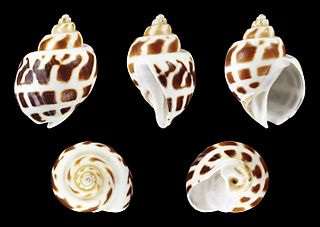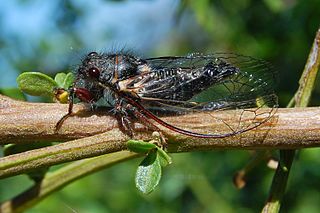
Lorinseria is a genus of fern in the subfamily Woodwardioideae of the family Blechnaceae. Its only species is Lorinseria areolata, the netted chain fern, native to eastern North America. The monotypic genus Lorinseria has been separated from Woodwardia in the Pteridophyte Phylogeny Group classification of 2016, on the basis of its anastamosing veins and lobed frond form, as well as its more marked frond dimorphism. However, the genus name Lorinseria appears to be a later homonym of LorinseraOpiz, and will need to be replaced or conserved.

Woodwardia is a genus of ferns in the family Blechnaceae, in the suborder Aspleniineae of the order Polypodiales. Species are known as chain ferns. The genus is native to warm temperate and subtropical regions of the Northern Hemisphere. They are large ferns, with fronds growing to 50–300 cm long depending on the species.
Skenea areolata is a species of sea snail, a marine gastropod mollusk in the family Skeneidae.

Babylonia areolata is a species of sea snail, a marine gastropod mollusk in the family Babyloniidae.

Tanea areolata is a species of predatory sea snail, a marine gastropod mollusk in the family Naticidae, the moon snails.

The furrowed wood turtle is a species of turtle belonging to the genus Rhinoclemmys of the family Geoemydidae found in the Yucatán Peninsula and adjacent regions of Central America.
Diospyros areolata is a tree in the family Ebenaceae. It grows up to 30 metres (100 ft) tall. Twigs are reddish brown when young. Inflorescences usually bear three flowers. The fruits are round, up to 4 cm (2 in) in diameter. The specific epithet areolata is from the Latin meaning "net-like", referring to the leaf veins. Habitat is lowland mixed dipterocarp and swamp forests. D. areolata is found in Peninsular Thailand, Sumatra, Peninsular Malaysia, Java and Borneo.

Manicina areolata, commonly known as rose coral, is a colonial species of stony coral. It occurs in shallow water in the West Atlantic Ocean and Caribbean Sea, sometimes as small solid heads and sometimes as unattached cone-shaped forms.
Metaclisis is a genus of parasitoid wasps in the family Platygastridae. There are at least 30 described species in Metaclisis.
Platypedia bernardinoensis is a species of cicada in the family Cicadidae. It is found in North America.

Platypedia is a genus of cicadas in the family Cicadidae. There are more than 20 described species in Platypedia.

Platypedia putnami is a species of cicada in the family Cicadidae. It is found in North America.
Platypedia barbata is a species of cicada in the family Cicadidae. It is found in North America.

Platypedia minor is a species of cicada in the family Cicadidae. It is found in Central America and North America.
Evaniella is a genus of ensign wasps in the family Evaniidae. There are more than 70 described species in Evaniella.
Dictyssa is a genus of tropiduchid planthoppers in the family Tropiduchidae. There are about 17 described species in Dictyssa.
Platypedia mohavensis is a species of cicada in the family Cicadidae. It is found in North America.

Sigmoria is a genus of flat-backed millipedes in the family Xystodesmidae. There are more than 40 described species in Sigmoria.
Geodia areolata is a species of sponge in the family Geodiidae. It is found in the waters of the Gulf of Mannar, between the southeastern tip of India and the west coast of Sri Lanka. The species was first described by Henry John Carter in 1880.
Cercophora areolata is a member of the Ascomycota division, and is grouped into the Lasiosphaeriaceae family based on morphology. C. areolata is a coprophilous fungus that has been most recently isolated from porcupine dung. Defining features of C. areolata include: 1) ovoid-conical, glabrous ascomata, 2) black, carbonaceous, areolate peridium and 3) clavate-shaped, single-walled asci. From studies on C. areolata, this fungus produces multiple antifungal compounds, which inhibit other competitor fungi.








